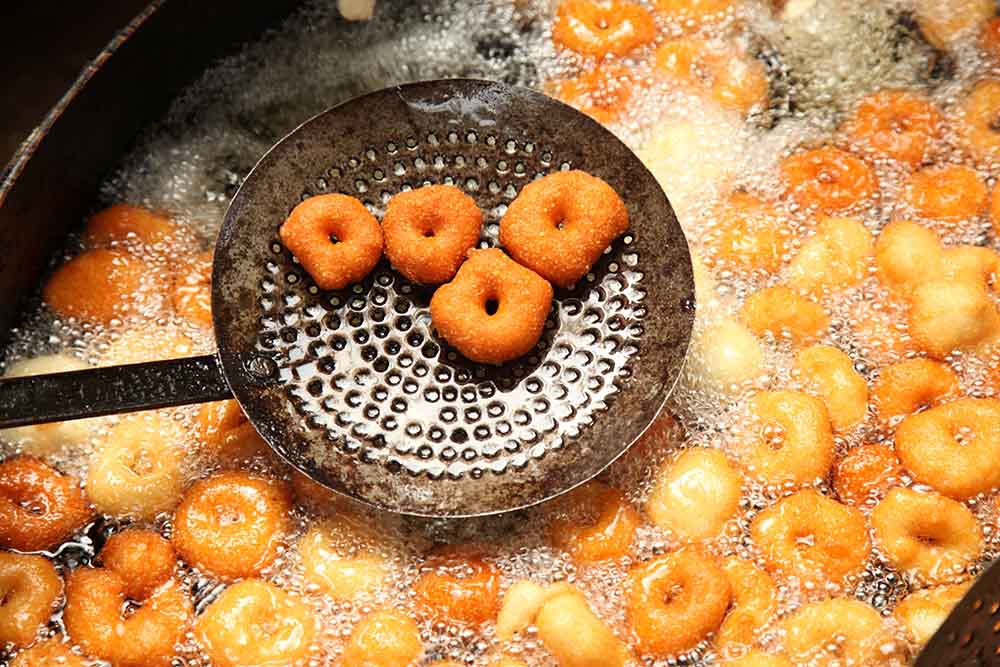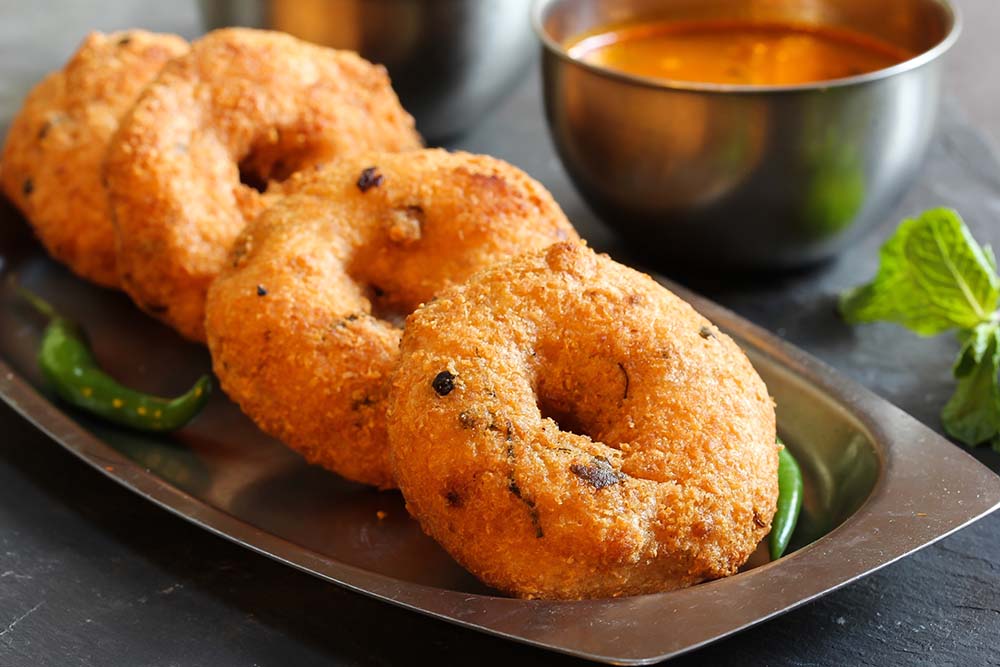Medu vada is a South Indian dish served with sambhar and chutney. It is enjoyed both as a breakfast snack and a main meal item. It has become so popular that it is commonly found served in restaurants in many parts of North India and even across the globe.
The vada is a doughnut-shaped fried snack made of lentil batter. It is usually crispy, fluffy and flavourful. ‘Medu’ means soft and ‘vada’ refers to a fried, savoury fritter.
While South Indian restaurants serve delicious medu vada, you can make it at home using an easy medu vada recipe. Most of the medu vada ingredients can easily found in any Indian kitchen, and are not difficult to procure even if you do not do Indian cooking.
Medu Vada Ingredients
If you want to know how to make medu vada, you need lentils, spices and some herbs. Medu vada is made of whole gram or split gram lentil, which are known as ‘urad dal’. ‘Dal’ means lentil.
• Lentils
Urad dal or split black gram is used for making medu vada. Whole black gram can also be used for the recipe.
• Batter
The lentils are mixed with water to it bring to a creamy consistency in order to make the batter.
• Herbs and spices
Onions, green chillies, curry leaves, cumin seeds, ginger, salt and crushed pepper are used to spice up the medu vada batter.
• Frying
The medu vadas are deep fried in oil.

Nutritional Value of Medu Vada
The chief ingredient of medu vada is lentils. Lentils are known to be a rich source of protein. It is also rich in vitamin B and carbohydrates.
It is said that pregnant women should consume more of urad dal as it provides folic acid, calcium, iron, magnesium and potassium, amongst other nutrients required by the body during that time. Urad dal is also known to help digestion. It has a high fibre content and provides relief to people suffering from colic disorder. The magnesium and potassium present in urad dal make it great for improving cardiovascular function. Its high iron content helps prevent anaemia.
With a host of benefits, urad dal and dishes made from it have high nutritional value.
Easy Medu Vada Recipe
Soaking Lentils
• Take one cup of urad dal in a bowl or pan. If it is good quality, it will be quite clean. Still, check for any impurities and pick the dal, that is, remove any particles from it.
• Then, rinse the dal well a few times. Rinse it with tap water a few times, and then rinse with drinking water.
• Soak the dal in around three cups of drinking water. Leave it soaked overnight or for at least 5 hours.
• Once you are ready to use the soaked dal to make the batter, discard the water it was soaked in.
Making Urad Dal Batter
Once you have taken the soaked dal and rinsed out the water, put the dal in a grinder jar. Add a few teaspoons of fresh water to the dal. Make sure you do not add too much water.
The batter for making medu vada needs to be light and fluffy, and not very thin. If it becomes too watery, the vadas will not turn out well.
The trick is to add water only in very little quantity, and if necessary. The correct consistency in making the batter is very important.
Once you start grinding, make sure all the dal is blended properly. Pieces of dal should not remain in the batter. Keep scraping the sides of the grinder to ensure the dal gets blended in and makes a smooth batter. Lift the batter with a spoon or whisk to aerate it.
Adding Spices and Herbs to the Batter
Once the batter is ready, you need to add spices and herbs to it. Finely chopped onions can be added as per taste. You can add a third of a cup, or more if you like more chunks of onion in your food. Finely chopped curry leaves, fresh coriander leaves and fresh ginger go in next.
Then, add one pinch of asafoetida, a pinch of cumin seeds and salt to taste. You also need to add pepper. You can either use half a teaspoon of crushed pepper or whole peppercorns if you choose.
Lastly, add in about one fourth cup of freshly grated coconut. If you like, you can also use coconut cut into small pieces.
Mix all the ingredients well into the batter. Taste it to check if more salt is necessary.
Shaping and Frying the Medu Vada
To shape the medu vada, keep a bowl of water next to the bowl with the batter. Take some water in both your palms, and then take a small amount of the batter. Make a circular shape with the batter. Once you have this round shape, create a hole in the centre with your thumb, to give it the doughnut shape.
To fry the vadas, heat oil in a pan. Once it becomes hot, put a small bit of the batter in it gently to check if it starts sputtering. If it does, the oil is hot enough for frying.
Gently slide the shaped vadas into the pan with oil in it. Fry the vadas in small batches on medium heat.
Remove from the pan when they are golden brown on all sides.

Pro Tips for Making Medu Vada
Grinding the dal
When grinding dal to make the batter, make sure you do not grind for too long. This will make the batter more like a paste and shaping the vadas will become difficult.
Batter consistency
The batter should not have a very watery consistency. You need to add very little water to grind the dal. Add water only bit by bit, and only if more is necessary. In case the batter does become too watery, add some rice flour to it to thicken it. This will also make the vadas crispy.
Frying the vadas
When frying vadas, the temperature of the oil is of utmost importance. The oil should be heated well before you start frying. You can check if it is hot enough by dropping a small piece of the batter into it. If it starts sputtering and rises to the top, the oil is hot. If the batter sinks to the bottom, you need to wait for it to become hot.
The oil should also not turn too hot to fry the vadas. In this case, the vadas might look golden brown from the outside, but will remain uncooked from the inside.
Variations of Vada
There are various variations of the versatile and delicious vada. Here are some of them.
• Masala Vada
This variety is made out of chana dal, spices, and some herbs and vegetables such as onions, ginger, curry leaves and fresh coriander. This is a delicious snack that can be served with mint chutney or tomato ketchup. It makes for a great breakfast item or snack for a party.
• Batata Vada
‘Batata’ refers to potatoes. Batata vada is a popular street food of Maharashtra that uses potatoes. It is another extremely popular Maharashtrian street food that goes well with pav, and is the chief ingredient of the famous vada pav.
• Sabudana Vada
This type of vada is popular during festivals and periods of fasting. It is made of sabudana or small tapioca pearls. Potatoes, peanuts, sesame seeds and some other herbs and spices are other ingredients used to make sabudana vada.
• Dahi Vada
This famous dish from North India is made by soaking the urad dal vada in water to make it soft and spongy. Then it is added in whisked yoghourt, with some spices added to it, to make it a popular chaat item.
Conclusion
Medu vada is a versatile savoury snack that can be served with sambhar and chutney, pav bread, or yoghourt. While it requires a few simple ingredients at home, the technique to make it at home requires a little bit of practice.
Getting the right consistency for the batter, and frying the vadas the correct way are the two most important aspects of making medu vada.
FAQs
What will happen if the batter is too thin?
If your vada batter becomes too thin, you will not be able to make the vadas properly. To thicken the batter, add some rice flour to it.
For how long should the dal for vada batter be soaked?
The dal should be soaked overnight, or for at least four to five hours.
Can the vada batter be made one day ahead of cooking the vadas?
The vada batter can be prepared a day ahead and kept in the fridge. It should be taken out some time before frying so that it reaches room temperature.